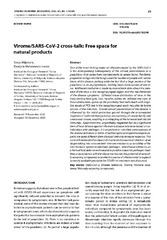Приказ основних података о документу
Virome/SARS-CoV-2 cross-talk: Free space for natural products
Virom/SARS-CoV2 interakcija: Upražnjeno mesto za prirodne komponente
| dc.creator | Mijatović, Sanja | |
| dc.creator | Maksimović-Ivanić, Danijela | |
| dc.date.accessioned | 2021-03-29T09:13:18Z | |
| dc.date.available | 2021-03-29T09:13:18Z | |
| dc.date.issued | 2020 | |
| dc.identifier.issn | 0018-6872 | |
| dc.identifier.uri | https://radar.ibiss.bg.ac.rs/handle/123456789/4168 | |
| dc.identifier.uri | http://hrana-ishrana.org/wp-content/uploads/2021/03/Broj-2-Vol-61-2020.pdf | |
| dc.description.abstract | One of the most striking marks of infection caused by the SARS-CoV-2 is the distinguishing heterogeneity of the clinical presentations in a population that varies from asymptomatic to severe forms. Pandemic proportion brings into the foreground the number of people with severe forms of the disease, putting aside the fact that a large portion of the population is asymptomatic, making them silent carriers of the virus. Additional confusion is made by inconsistent data about the presence of the virus in the nasopharyngeal region and the manifestation of the disease symptoms. Different tissue distribution of virus in the body starting from guts, liver, muscles, kidney, etc. without any signs of tissue destruction, opens up the possibility that individuals with negative results of PCR test in the nasopharyngeal swab may also be latent carriers of the infection. Overall clinical presentation of the disease is influenced by the initial protection gained through the accumulated “experience” collected from the previous encountering of corona family and noncorona viruses, resulting in overlapping of the humoral and cellular immunity. Apart from this, an unjustifiably neglected but very significant form of host defense against infection is disease tolerance based on cohabitation with the pathogen. It is important to note that consequences of the disease tolerance in terms of pathological and epidemiological aspects are quite different then classical antiviral immune response. This work will elaborate the impact of virome on the course of infection at all stages taking into account both immune resistance, as an ability of the host immune system to eliminate the pathogen, and disease tolerance, as a form of host defense with neutral to positive impact to pathogen load. Also, in accordance with the above mentioned, the potential of naturally occurring compounds to profile the course of infection and to support currently available protocols for COVID-19 treatment was discussed | en |
| dc.description.abstract | Jedna od najupečatljivijih oznaka infekcije uzrokovane SARS-CoV-2 je heterogenost kliničke slike u populaciji koja varira od asimptomatske do teške forme. Pandemijska srazmera čini da brojnost ljudi sa teškom formom bolesti dolazi do izražaja, potiskujući činjenicu da je veliki deo populacije asimptomatski nosioc virusa. Dodatnu konfuziju unose nekonzistentni podaci o prisustvu virusa u brisu nazofaringealne regije i ispoljavanja bolesti. Različita distribucija virusa u telu, počevši od creva, preko jetre, mišića, bubrega itd., a bez znakova tkivnog oštećenja, otvara mogućnost da osobe sa negativnim rezultatima PCR testa u nazofaringealnom brisu mogu biti latentni nosioci infekcije. U osnovi različite kliničke slike bolesti može biti inicijalna protekcija prema SARS-CoV-2 infekciji stečena akumuliranim „iskustvom“ u susretu sa drugim pripadnicima porodice korona ali i nekorona virusa, koja je ishodovala formiranjem humoralnog i celularnog imuniteta sa preklapajućim repertoarom. Osim toga, neopravdano zapostavljeni, ali vrlo značajan oblik odbrane domaćina od infekcije je tolerancija na bolest koja se temelji na suživotu s patogenom. Važno je napomenuti da su posledice tolerancije na bolest u smislu patoloških i epidemioloških aspekata prilično različite od klasičnog imunskog odgovora. Ovaj rad će diskutovati uticaj viroma na tok infekcije u svim fazama uzimajući u obzir oba- klasični imunski odgovor sa ciljem eliminacije patogena i sticanje tolerancije na bolest, kao oblik odbrane domaćina od infekcije u suživotu sa patogenom koji može da varira od neutralnog do sibmiotskog. Takođe, u skladu s gore spomenutim, razmatraće se o potencijal komponenata iz prirode da oblikuju tok infekcije i pruže podršku aktuelnim terapeutskim pristupima u lečenju COVID-19. | sr |
| dc.language.iso | en | sr |
| dc.publisher | Belgrade: Nutrition Society | sr |
| dc.relation | info:eu-repo/grantAgreement/MESTD/inst-2020/200007/RS// | sr |
| dc.rights | openAccess | sr |
| dc.source | Hrana i ishrana | sr |
| dc.subject | SARS-CoV-2 | |
| dc.subject | Disease tolerance | en |
| dc.subject | Virome | en |
| dc.subject | Immune resistance | en |
| dc.subject | Naturally occurring compounds | en |
| dc.subject | Tolerancija na bolest | sr |
| dc.subject | Virom | sr |
| dc.subject | Imunski odgovor | sr |
| dc.subject | Prirodne komponente | sr |
| dc.title | Virome/SARS-CoV-2 cross-talk: Free space for natural products | en |
| dc.title | Virom/SARS-CoV2 interakcija: Upražnjeno mesto za prirodne komponente | sr |
| dc.type | article | sr |
| dc.rights.license | ARR | sr |
| dcterms.abstract | Мијатовић, Сања; Максимовић-Иванић, Данијела; Вироме/СAРС-ЦоВ-2 цросс-талк: Фрее спаце фор натурал продуцтс; Вироме/СAРС-ЦоВ-2 цросс-талк: Фрее спаце фор натурал продуцтс; | |
| dc.rights.holder | © 2020 by the Nutrition Society | sr |
| dc.citation.issue | 1 | |
| dc.citation.volume | 61 | |
| dc.identifier.doi | 10.5937/hraIsh2001025M | |
| dc.citation.apa | Mijatović, S. & Maksimović-Ivanić, D. (2020). Virome/SARS-CoV-2 cross-talk: Free space for natural products. Hrana i Ishrana, 61(1), 25. | |
| dc.citation.vancouver | Mijatović S, Maksimović-Ivanić D. Virome/SARS-CoV-2 cross-talk: Free space for natural products. Hrana i Ishr. 2020;61(1):25. | |
| dc.citation.spage | 25 | |
| dc.type.version | publishedVersion | sr |
| dc.identifier.fulltext | https://radar.ibiss.bg.ac.rs/bitstream/id/8291/bitstream_8291.pdf | |
| dc.citation.rank | M52 |

